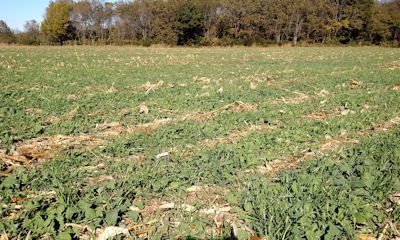
Unseasonably warm conditions in November and December gave cover crops plenty of time to flourish. The extended growing season opens up a question: will cover crops, such as annual ryegrass, be harder to terminate this spring?
Pete Fandel, cover crop specialist with the Illinois Council on Best Management Practices (C-BMP), says a longer growing season doesn’t necessarily mean a more challenging termination. However, farmers who planted cover crops last fall will have to be on their toes.

COVER PRACTICES: If you’re new to cover crops it’s a good idea to pay attention to spring growth for best management.
“Basically, farmers will have to be a little more diligent in the spring when it starts to warm up. Watching those cover crops and seeing what height they are comfortable still killing them, depending on the species they have planted,” says Fandel. “And they may have to spray a little earlier than they originally intended, just because of the height or the stage of the plants.”
According to Fandel, the key to controlling the most challenging cover crop, annual ryegrass, is to get ahead of it. The larger it gets, the harder it will be to terminate. Fandel offers a few tips for effective annual ryegrass termination.
Watch plant height.
Terminate before it grows to 7 to 10 inches in height, or before jointing.
Keep a close eye on the thermometer.
Daytime temperatures should be above 50 degrees and nighttime temperatures shouldn’t go much below 40 degrees.
Listen to the forecast.
If freezing temperatures are in the forecast, wait at least a couple of days. Freezing temps will cause the plant to shut down, making herbicide uptake difficult.
Tank mix with care.
Add AMS to the spray tank before glyphosate. Do not add triazines or Callisto to the mix, it will impact effectiveness. Also, use no more than 10 gallons of water per acre to concentrate the amount of glyphosate going into the plants.
Watch the clock.
Park the sprayer around 2 p.m. in the afternoon. Glyphosate takes about four hours to translocate. Spraying too late in the day, especially on cool spring days, may prohibit glyphosate from working effectively.
Other popular cover crops, such as cereal rye and crimson clover, can be easily terminated through burndown programs.
Overall, Fandel isn’t too concerned about cover crop termination this spring. “Depending on the species they planted, a lot of farmers are very comfortable letting cover crops get fairly good sized. It probably won’t affect them too much either way,” says Fandel.
For farmers new to cover crops, Fandel recommends keeping a close eye on fields. “They’ll have to be a little more vigilant and pay close attention to how soon they start to grow in the spring.”
For more information on cover crops, visit Illinois Council on Best Management Practices.
About the Author(s)
You May Also Like




